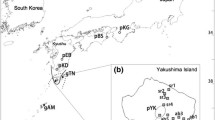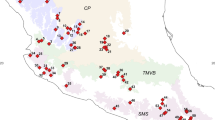Abstract
Field studies and conceptual work on hybridization-mediated extinction risk in climate relicts are extremely rare. Nuphar pumila (Nymphaeaceae) is one of the most emblematic climate relicts in Europe with few isolated populations in the Alpine arc. The extent of introgression with related lowland and generalist species Nuphar lutea has never been studied using molecular methods. All biogeographical regions where N. pumila naturally occurs in the neighbourhood of the Alpine arc were sampled and studied using nuclear microsatellite markers. Furthermore, we used forward-in-time simulations and Approximate Bayesian Computation to check whether an introgression scenario fits with the observed admixture patterns and estimated the demographic parameters associated with this process. Our study confirms ongoing hybridization between N. pumila and N. lutea and validates it by the use of population models. More than 40 % of investigated N. pumila individuals were admixed and hybrids were found in over 60 % of studied populations. The introgression is bidirectional and is most likely a result of very recent gene flow. Our work provides strong evidence for rapid extinction risk and demographic swamping between specialized climatic relicts and closely related generalists. The remaining pure populations of N. pumila are rare in the Alpine arc and deserve high conservation priority.



Similar content being viewed by others
References
Alcala N, Streit D, Goudet J, Vuilleumier S (2013) Peak and persistent excess of genetic diversity following an abrupt migration increase. Genetics 193:953–971
Arrigo N, Buerki S, Sarr A, Guadagnuolo R, Kozlowski G (2011) Phylogenetics and phylogeography of the monocot genus Baldellia (Alismataceae): mediterranean refugia, suture zones and implications for conservation. Mol Phylogenet Evol 58:33–42
Balao F, Casimiro-Soriguer R, García-Castaño JL, Terrab A, Talavera S (2015) Big thistle eats the little thistle: does unidirectional introgressive hybridization endanger the conservation of Onopordum hinojense? New Phytol 206:448–458
Barton NH (2001) The role of hybridization in evolution. Mol Ecol 10:551–568
Becker M, Gruenheit N, Steel M, Voelckel C, Deusch O, Heenan PB, McLenachan PA, Kardaisky O, Leigh JW, Lockhart PJ (2013) Hybridization may facilitate in situ survival of endemic species through periods of climate change. Nat Clim Change 3:1039–1043
Brown LE (1971) Natural hybridization and trend toward extinction in some relict texas toad populations. Southwest Nat 16:185–199
Buerkle CA (2005) Maximum-likelihood estimation of a hybrid index based on molecular markers. Mol Ecol Notes 5:684–687
Chapman MA, Burke JM (2007) Genetic divergence and hybrid speciation. Evolution 61–67:1773–1780
Chase WM, Hills HG (1991) Silica gel: an ideal material for field preservation of leaf samples for DNA studies. Taxon 40:215–220
Csilléry K, François O, Blum MGB (2012) abc: an R package for approximate Bayesian computation (ABC). Methods Ecol Evol 3:475–479
Delplancke M, Alvarez N, Benoit L, Espíndola A, Jolz HI, Neuenschwander S, Arrigo N (2012) Evolutionary history of almond tree domestication in the mediterranean basin. Mol Ecol 22:1092–1104
Dezhi F, Padgett D (2001) Genus Nuphar (Nymphaeaceae). Flora of China 6:115–116
Engler R, Randin C, Thuiller W, Dullinger S, Zimmermann A, Araùjo MB, Pearmann PB, Le Lay G, Piédallu C, Albert CH et al (2011) 21st century climate change threatens mountain flora unequally across Europe. Glob Change Biol 17:2330–2341
Excoffier L, Foll M, Petit R (2009) Genetic consequences of range expansions. Annu Rev Ecol Evol Syst 40:481–501
Fedorov AA (1974) Chromosome numbers of flowering plants. Academy of Natural Sciences of the USSR, Leningrad
Fitzpatrick B (2012) Estimating ancestry and heterozygosity of hybrids using molecular markers. BMC Evol Biol 12:131
Garnett ST, Olsen P, Butchart SHM, Hoffmann AA (2011) Did hybridization save the Norfolk Island boobook owl Ninox novaeseelandae undulata? Oryx 45:500–504
Garroway CJ, Bowman J, Cascaden TJ, Holloway GL, Mahan CG, Malcolm JR, Steele MA, Turner G, Wilson PJ (2010) Climate change induced hybridization in flying squirrels. Glob Change Biol 16:113–121
Gómez JM, González-Megías A, Lorite J, Abdelaziz M, Perfectti F (2015) The silent extinction: climate change and the potential hybridization-mediated extinction of endemic high-mountain plants. Biodivers Conserv 24:1843–1857
Hampe A, Jump AS (2011) Climate relicts: past, present, future. Annu Rev Ecol Evol 42:313–333
Hegarty MJ, Hiscock SJ (2005) Hybrid speciation in plants: new insights from molecular studies. New Phytol 165:411–423
Heslop-Harrison Y (1953) Nuphar intermedia Lebed., a presumed relict hybrid in Britain. Watsonia 3:7–25
Heslop-Harrison Y (1955) Nuphar Sm. J Ecol 43:342–364
Kabátova K, Vít P, Suda J (2014) Species boundaries and hybridization in central-European Nymphaea species inferred from genome size and morphometric data. Preslia 86:131–154
Käsermann Ch, Moser DM (1999) Merkblätter Artenschutz, Blütenpflanzen und Farne. Bern, Switzerland: Bundesamt für Umwelt, Wald und Landschaft (BUWAL)
Kozlowski G, Eggenberg S (2005) Vorkommen der Kleinen Teichrose Nuphar pumila und des Hybrids N. x intermedia in der Schweiz. Bot Helv 115:125–136
Levin DA, Francisco-Ortega J, Jansen RK (1996) Hybridization and the extinction of rare plant species. Conserv Biol 10:10–16
López-Caamal A, Cano-Santana Z, Jiménez-Ramírez J, Ramírez-Rodríguez R, Tovar-Sánchez E (2014) Is the insular endemic Psidium socorrense (Myrtaceae) at risk of extinction through hybridization? Plant Syst Evol 300:1959–1972
Lozano FD, Moreno Saiz JC, Sainz Ollero H, Herbada DG, Rivero LM (2008) Lista roja de la flora vascular espanola. Conservation Vegetal, Madrid
Mallet J (2007) Hybrid speciation. Nature 446:279–283
Meusel H, Mühlberg H, Fuchs HP (1965) Nymphaeaceae. In: Hegi G, ed, Illustrierte Flora von Mitteleuropa. Band III. Teil 3, München edn. Carl Hanser, Germany
Muhlfeld CC, Kovach RP, Jones LA, Al-Chokhachy R, Boyer MC, Leary RF, Lowe WH, Luikart G, Allendorf FW (2014) Invasive hybridization in a threatened species is acceleratedby climate change. Nat Clim Change 4:620–624
Neuenschwander S, Hospital F, Guillaume F, Goudet J (2008) Quantinemo: an individual-based program to simulate quantitative traits with explicit genetic architecture in a dynamic metapopulation. Bioinformatics 24:1552–1553
Nierbauer KU, Kanz B, Zizka G (2014) The widespread naturalisation of Nymphaea hybrids is masking the decline of wild-type Nymphaea alba in Hesse, Germany. Flora 209:122–130
Oberdorfer E (1977) Süddeutsche Pflanzengesellschaften. Teil I, Zweite edn. Gustav Fischer, Stuttgart
Ouborg NJ, Goodall-Copestake WP, Saumitou-Laprade P, Bonnin I, Epplen JT (2000) Novel polymorphic microsatellite loci isolated from the yellow waterlily, Nuphar lutea. Mol Ecol 9:497–498
Padgett DJ (1998) Phenetic distinction between the dwarf yellow water-lilies: Nuphar microphylla and N. pumila (Nymphaeaceae). Can J Bot 76:1755–1762
Padgett DJ (2007) A monograph of Nuphar (Nympheaceae). Rhodora 109:1–95
Padgett DJ, Les DH, Crow GE (1998) Evidence for the hybrid origin of Nuphar × rubrodisca (Nymphaeaceae). Am J Bot 85:1468–1476
Padgett DJ, Les DH, Crow GE (1999) Phylogenetic relationships in Nuphar (Nymphaeaceae): evidence from morphology, chloroplast DNA, and nuclear ribosomal DNA. Am J Bot 86:1316–1324
Padgett DJ, Shimoda M, Horky LA, Les DH (2002) Natural hybridization and the imperiled Nuphar of western Japan. Aquat Bot 72:161–174
Pajkovic M, Lappe S, Barman R, Parisod C, Neuenschwander S, Goudet J, Alvarez N, Guadagnuolo R, Felber F, Arrigo N (2014) Wheat alleles introgress into selfing wild relatives: empirical estimates from approximate Bayesian computation in Aegilops triuncialis. Mol Ecol 23:5089–5101
Preston CD, Croft JM (2001) Aquatic plants in Britain and Ireland. Harley Books, Colchester
Rhymer JM, Simberloff D (1996) Extinction by hybridization and introgression. Annu Rev Ecol Syst 27:83–109
Rieseberg RH (1997) Hybrid origins of plant species. Annu Rev Ecol Syst 28:359–389
Rieseberg RH, Baird SJE, Gardner KA (2000) Hybridization, introgression, and linkage evolution. Plant Mol Biol 42:205–224
Roweck H (1988) Ökologische Untersuchungen an Teichrosen. Archiv für Hydrobiologie. Stuttgart, Germany: E. Schweizerbart’sche Verlagsbuchhandlung, Supplementband. 81 Heft 2/3. Nägele u. Obermiller
Roweck H, Reinöhl H (1986) Zur verbreitung und systematischen abgrenzung der teichrosen Nuphar pumila und N. × intermedia in Baden-Württemberg. Veröffentlichungen Landesstelle Naturschutz Baden-Württemberg 61:81–151
Shiga T, Kadono Y (2007) Natural hybridization of the two Nuphar species in northern Japan: homoploid hybrid speciation in progress? Aquat Bot 86:123–131
Shiga T, Kadono Y (2008) Genetic relationships of Nuphar in central to western Japan as revealed by allozyme analysis. Aquat Bot 88:105–112
Theurillat JP, Guisan A (2001) Potential impact of climate change on vegetation in the European alps: a review. Clim Change 50:77–109
Thórsson AT, Pálson S, Lascoux M, Anamthawat-Jónson K (2010) Introgression and phylogeography of Betula nana (diploid), B. pubescens (tetraploid) and their triploid hybrids in Iceland inferred from cpDNA haplotype variation. J Biogeogr 37:2098–2110
Todesco M, Pascual MA, Owens OL, Ostevik KL, Moyers BT, Hübner S, Heredia SM, Hahn MA, Casseys C, Bock DG, Rieseberg LH (2016) Hybridization and extinction. Evol Appl. doi:10.1111/eva.12367
Vilà M, Weber E, D’Antonio CM (2000) Conservation implications of invasion by plant hybridization. Biol Invasions 2:207–217
Whitney KD, Ahern JR, Campbell LG, Albert LP, King MS (2010) Patterns of hybridization in plants. Perspect Plant Ecol Evol Syst 12:175–182
Wolf DE, Takebayashi N, Rieseberg LH (2001) Predicting the risk of extinction through hybridization. Conserv Biol 15:1039–1053
Woolbright SA, Whitham TG, Gering CA, Allan GJ, Bailey JK (2014) Climate relicts and their associated communities as natural ecology and evolution laboratories. Trends Ecol Evol 29:406–416
Yokogawa M, Shiga T, Kaneko S, Isagi Y (2012) Development of nuclear microsatellite markers for the critically endangered freshwater macrophyte, Nuphar submersa (Nymphaeaceae), and cross-species amplification in six additional Nuphar taxa. Conserv Genet Resour 4:295–298
Acknowledgments
We are grateful to the following persons and institutions for their precious help, collaboration and/or issue of permissions: Switzerland—Botanic Gardens of St-Gall, Zürich, Geneva, Lausanne and Fribourg; B. Clément and E. Kozlowski, Botanic Garden of the University of Fribourg; M. Achermann and F. Cheda, Service de la Nature et du paysage de l’Etat de Fribourg; A. Keel, Amt für Landschaft- und Naturschutz, Kanton Zürich; G. Ackermann, Amt für Natur Jagd und Fischerei, Abteilung Natur und Landschaft, Kanton Sankt Gallen; R. Züllig, Gemeindepräsident Gemeinde Wildhaus-Alt Sankt Johann; C. Huber, UNA, Bern; R. Heeb and Ch. Peisker, Kantonsschule Wattwil; L. Champoud and V. Kam, Collège du Sud, La Frasse; F. Genoud, Auberge du Lac des Joncs, Les Paccots; Coordination régionale pour la protection de la flore (FR-GE-NE-VD); S. Eggenberg, Info Flora; D. Vogt, Bern. France—E. Brugel, Conservatoire botanique national de Franche-Comté; S. Daucourt, Direction Régionale de l’Environnement, de l’Aménagement et du Logement de Franche-Comté (DREAL); A. David, Office National de l’Eau et des Milieux Aquatiques (ONEMA); A. Piot, Hôtel et lac de l’Abbaye, Grande-Rivière; owners of the pond Bachetey, Haute-Saône. Austria—M. Messner, Bezirkshauptmannschaft Reutte; municipalities of Grän and Nesselwängle, Tirol. Germany—G. Riegel, Regierungsbezirk Schwaben; K. Neugebauer, Regierungsbezirk Oberbayern; H. Lampartner, Regierungspräsidium Tübingen; B. Schmidt, Landratsamt Ravensburg; U. Weiland, Zweckverband Allgäuer Moorallianz; S. Socher, Bayerischen Landesamt für Umwelt in Augsburg; Naturpark Südschwarzwald; S. Rossiwal, Regierung von Oberbayern, U. Grabner, Starnberg; J. Kunsler, Bad Endorf; NSG Eggstätt-Hemhofer Seenplatte; B. Zimmermann, Regierungspräsidium Freiburg. We thank the Natural History Museum Fribourg (Switzerland) and the Fonds de recherche of the University of Fribourg (Switzerland, project number 516) for their logistic and financial support. N.A. is funded by an SNSF Ambizione research grant (PZ00P3_148224). We thank also two anonymous reviewers for their constructive comments, which helped us to improve the manuscript.
Author information
Authors and Affiliations
Corresponding author
Additional information
Communicated by Kevin Edwards.
Electronic supplementary material
Below is the link to the electronic supplementary material.
Rights and permissions
About this article
Cite this article
Arrigo, N., Bétrisey, S., Graf, L. et al. Hybridization as a threat in climate relict Nuphar pumila (Nymphaeaceae). Biodivers Conserv 25, 1863–1877 (2016). https://doi.org/10.1007/s10531-016-1165-z
Received:
Revised:
Accepted:
Published:
Issue Date:
DOI: https://doi.org/10.1007/s10531-016-1165-z




